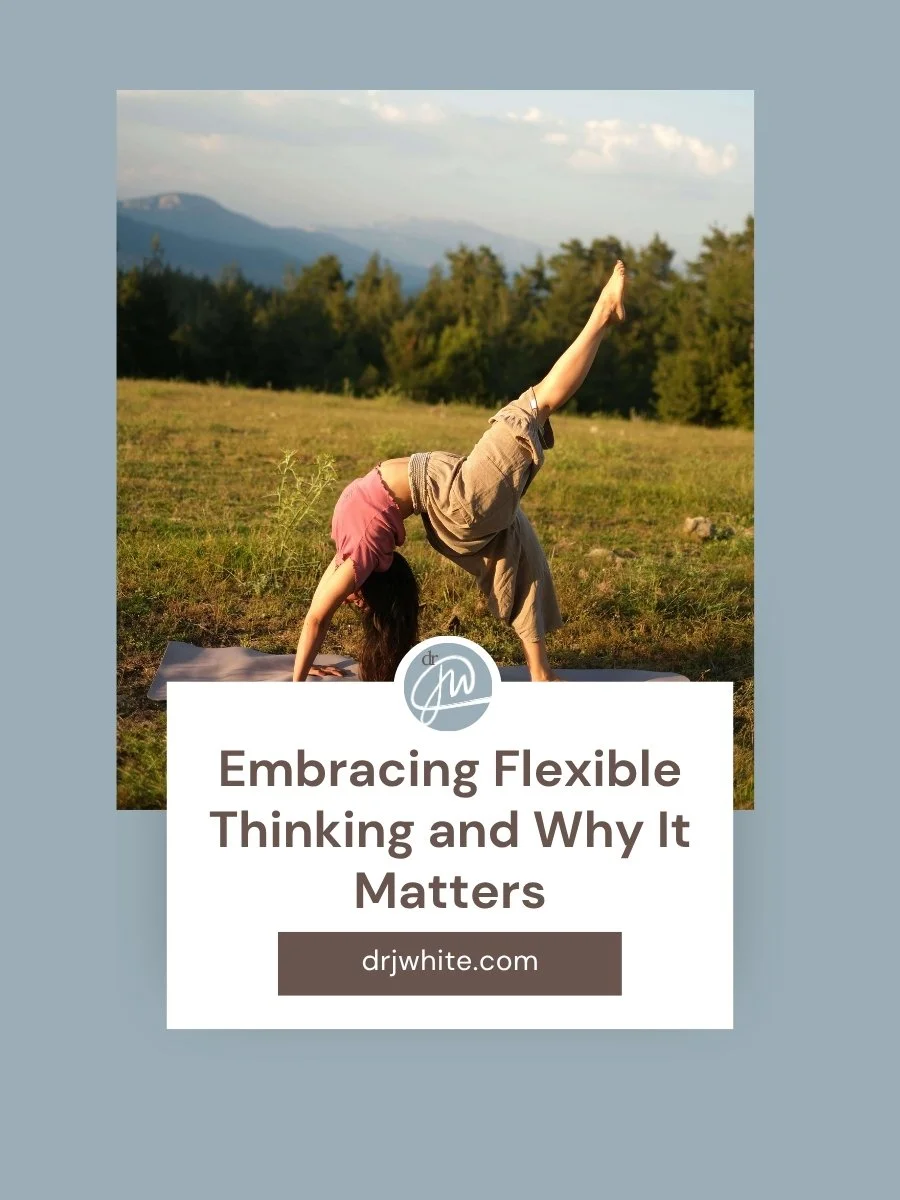Embracing Flexible Thinking and Why It Matters
When we think about physical flexibility, we imagine being able to move our bodies with ease—stretching, bending, and flowing without pain or strain. A flexible body can handle movement with grace, in contrast to the stiffness or restricted range of motion that comes with inflexibility. You might even picture the familiar phrase “bend, but don’t break.” Flexibility allows us to weather stress and recover more easily.
Now, what if we applied that same concept to our minds and emotions? What would it mean to have mental flexibility?
DISCLAIMER: I am a licensed clinical psychologist, and the information provided here is for general informational and educational purposes only. While I aim to share helpful and thoughtful content, reading this blog does not establish or imply a therapist-client relationship between us.
If you are experiencing a mental health crisis, please seek immediate help from a licensed professional or contact emergency services in your area. This blog should not be a substitute for professional mental health care or personalized guidance.
For personalized support or therapy services, please reach out directly to a licensed mental health provider in your area.
Mental Flexibility Meaning: What It Looks Like in Real Life
Psychological flexibility is the ability to shift your thinking, adapt to new situations, and respond to challenges without getting stuck in rigid patterns.
Flexible vs. Rigid Thinking
In contrast, mental rigidity, or rigid thinking, often involves needing things to be “just so” in order to feel comfortable or satisfied. It might look like resisting change, avoiding anything outside a narrow definition of success or goodness, or becoming easily overwhelmed when things don’t go as planned.
A flexible mindset allows you to tolerate uncertainty, adapt to unexpected events, and regulate your emotional responses. This kind of openness enhances communication, problem-solving, and resilience. It helps you see things from multiple perspectives and navigate life’s inevitable curveballs with more ease.
Wanting vs. Willingness: A Key Distinction
There’s a meaningful difference between wanting something and being willing to experience it. (Read more about Acceptance in this blog post.)
Let’s say you have dinner plans with a close friend on Saturday night. You’re an introvert and have been looking forward to some one-on-one time. At the last minute, your socially adventurous friend invites someone else to join—someone you don’t know. You didn’t want that to happen, but can you be willing to go with it?
Willingness means acknowledging reality without resistance. It doesn’t mean pretending you’re thrilled or forcing positivity. It simply means accepting the situation as it is and choosing to engage with it openly. That openness might make you more welcoming, polite, and even pleasantly surprised by the evening. On the other hand, a rigid mindset could lead to disengagement or frustration, creating tension for you and others.
How to Improve Mental Flexibility in Daily Life
Here are a few ways to begin building more mental flexibility:
1. Openness to New Experiences Supports Growth
Be open to experiences and emotions—even the uncomfortable ones. If you only engage with what feels safe or familiar, you may miss out on meaningful connections, growth, and opportunities. Openness expands your world.
2. Noticing Patterns and Accepting Discomfort
Mindfulness helps you develop awareness of your internal experience without judgment. Pay attention to moments when you feel yourself becoming rigid or reactive. What stories is your mind telling you? What assumptions or fears are driving your reaction? Simply noticing these patterns can help you begin to shift them.
(Interested in learning more about Mindfulness? Here’s the blog post.)
3. Curiosity and Emotional Adaptability Go Hand-in-Hand
Approach life with curiosity rather than avoidance. When you turn toward discomfort with a spirit of learning, you might discover unexpected insights, strengths, or even joy. Curiosity helps you stay engaged, even in the face of uncertainty.
(Learn more about leaning into discomfort with this blog post: Pain Is Inevitable, Suffering is Optional)
Rooted in Values, Flexible in Practice
Imagine a tree. Its roots anchor it deeply into the earth—just as our values keep us grounded and aligned with what truly matters. But a healthy tree also has branches and leaves that move with the wind. Without that flexibility, a strong storm could snap the tree in half.
We need both: strong roots and adaptable branches. Our values help us know when to bend and when to hold firm. Our flexible mindset allows us to grow, learn, and respond to life’s storms without breaking.
(Want to know more about values and how to identify yours? Add this blog to your reading list.)
Balancing Flexibility and Boundaries Takes Practice
Of course, it's not always easy to know when to be flexible and when to hold a boundary. It takes self-awareness, practice, and sometimes support to navigate those moments of choice. If you’re feeling stuck, overwhelmed, or unsure how to begin building more mental flexibility, I’d love to help.







